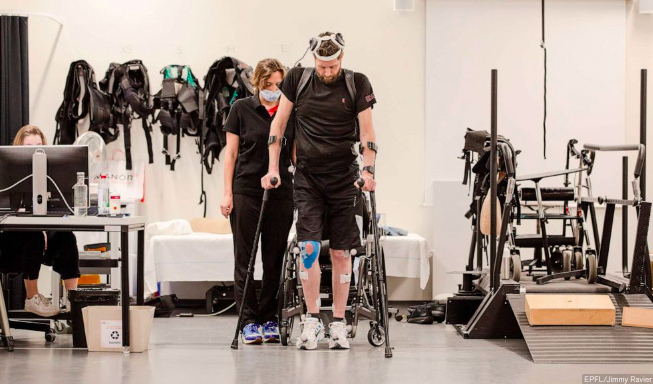
A remarkable medical breakthrough that could revolutionize paralysis treatment was recently achieved at the Vaud University Hospital in Lausanne, Switzerland. A team of neuroscientists have developed a brain-spine interface that has enabled a quadriplegic man to stand and walk again. The team, led by professor Gregoire Courtine of the Swiss Federal Institute of Technology in Lausanne, previously tested the device on apes before experimenting on Oskam — and reported a successful result.
Gert-Jan Oskam, a 40-year-old Dutchman, had been wheelchair-bound since his spinal cord was damaged in a bicycle accident 12 years ago. However, he has now become the first human to benefit from the new breakthrough, which is a combination of sophisticated brain technology and artificial intelligence.
The device creates a “digital bridge”, using two implants—one inserted into the spinal cord, and a more complex one into the brain. The brain implant consists of 64 electrodes, which collect brain signals, such as those generated by thoughts about walking. The signals are wirelessly transmitted to a computer on Oskam’s back, which then translates them into data that can be used to stimulate the nerve cells beneath the injury and move the patient’s muscles.
In order to reap the full benefits of the brain-spine interface, Oskam has had to undergo intensive training. For this, the patient was asked to imagine moving his legs, while the electrodes detected and collected the signals emitted by his brain. After months of training, Oskam regained the ability to voluntarily move his legs and feet, a feat that had not been possible with just spinal stimulation alone.
Now, with the help of a walker, Oskam is able to stand and take small steps. The device is still bulky—so far, it has not been miniaturized—but, with continual research and development, scientists hope to eventually make such technologies more accessible and viable for wider use.
The advances made with Oskam’s case could have positive implications in the treatment of paralysis and disability in the future. With patience and perseverance, the effects of quadriplegia and other traumatic injuries could potentially be reversed, and those affected could regain their independence and mobility. Oskam’s inspiring story may be the first of many that could follow, as scientists strive to revolutionize paralysis treatment using brain technology and artificial intelligence.